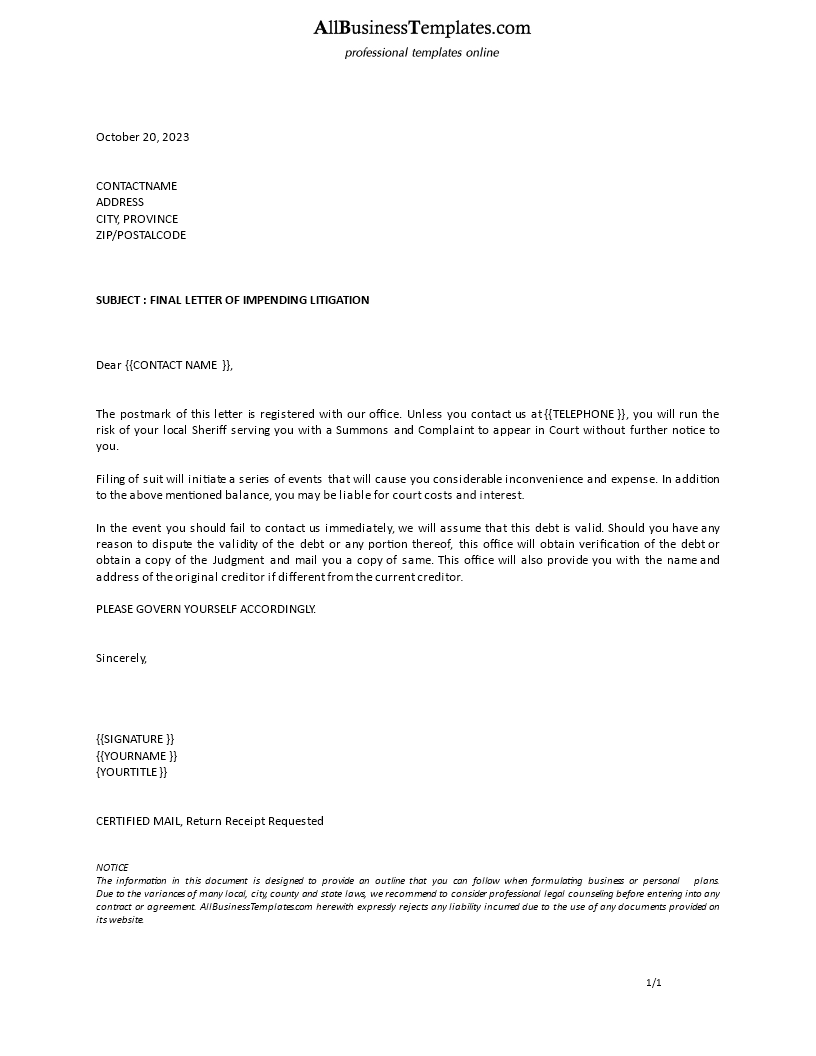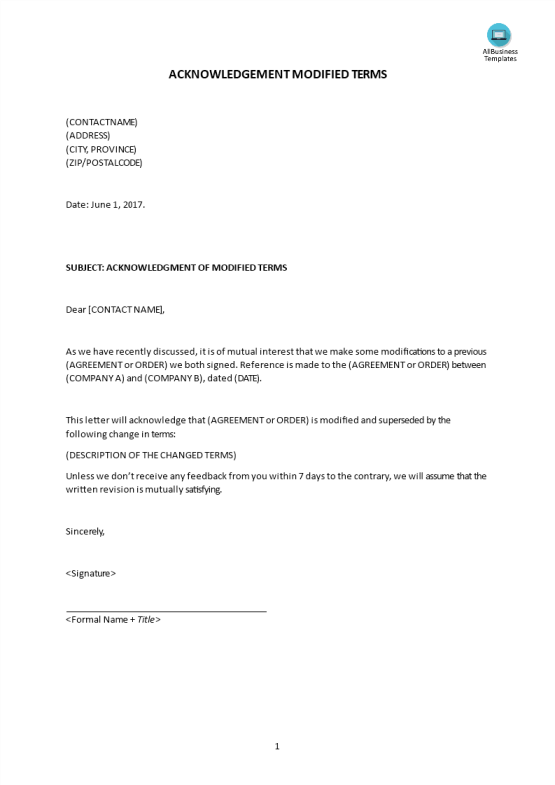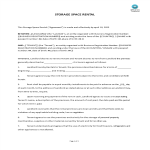Formal Letter Final Notice Litigation

Guardar, completar los espacios en blanco, imprimir, listo!
How should a final notice be written in order to make it as effective as possible? What is the purpose of a final notice letter? Download our Formal Letter Final Notice Litigation template now!
Formatos de archivo disponibles:
.docx- Este documento ha sido certificado por un profesionall
- 100% personalizable
Legal Jurídico Life Privado final notice letter carta de aviso final
How should a final notice be written in order to make it as effective as possible? What is the purpose of a final notice letter? Our Formal Letter Template for Final Notice Litigation contains all the necessary elements for such letters. This includes the date, the recipient's name and address, a clear statement of why you are writing, and a call to action. Download our Formal Letter Final Notice Litigation template now!
A "Formal Letter Final Notice Litigation" typically refers to a formal written communication sent by a legal entity or law firm to an individual or organization as a final warning or notification that legal action, specifically litigation, will be pursued if a certain matter is not resolved or addressed within a specified timeframe.
Here are some key components and characteristics of such a letter:
- Formal Tone: The letter is usually written in a formal and professional tone to emphasize the seriousness of the matter.
- Identification of Parties: The letter typically identifies the sender (the party pursuing legal action) and the recipient (the party against whom legal action is threatened).
- Description of the Issue: The letter outlines the specific issue or dispute that has led to the threat of litigation. This could involve contractual disputes, outstanding debts, non-compliance with legal obligations, or other legal matters.
- Prior Communication: It may mention any prior attempts at communication or resolution, such as previous warning letters or negotiation attempts, and explain why those attempts have been unsuccessful.
- Legal Basis: The letter may briefly cite the legal basis or grounds on which the threatened legal action is based. This could include references to relevant laws, regulations, or contractual terms.
- Demand or Expectation: The letter typically includes a demand or expectation for the recipient to take specific actions or remedies to resolve the issue. This might involve paying a debt, ceasing certain activities, providing requested information, or other actions.
- Timeframe: A clear deadline is usually provided within which the recipient is expected to respond or take the required actions. This timeframe is often referred to as the "final notice" period.
- Consequences of Inaction: The letter will explicitly state that if the recipient fails to comply with the demands or resolve the issue within the specified timeframe, the sender will initiate legal proceedings, which could lead to litigation in a court of law.
- Contact Information: Contact information for the sender's legal representative or law firm is typically provided in case the recipient wishes to discuss the matter or negotiate a resolution.
- Formal Closing: The letter concludes with a formal closing and may include a signature from the legal representative or attorney.
A "Formal Letter Final Notice Litigation" is a significant step in the legal process, indicating the sender's intent to pursue legal remedies to resolve a dispute. It is important for the recipient to take such letters seriously and seek legal counsel if necessary to understand their rights and options. Ignoring or failing to respond to a final notice of litigation can result in legal proceedings being initiated against the recipient.
To ensure the effectiveness of a final notice letter, it's essential to draft it thoughtfully and professionally. Here are key considerations and tips for writing an effective final notice:
- Clear and Concise Language:
- Use clear and straightforward language to explain the issue. Avoid jargon or complex terminology.
- Clearly state the purpose of the letter and the specific problem or obligation that needs attention.
- Professional Tone:
- Maintain a professional and respectful tone throughout the letter, even if the recipient has been unresponsive or non-compliant.
- Recipient Information:
- Include accurate and up-to-date contact information for both parties, including names, addresses, phone numbers, and email addresses.
- Subject Line:
- If sending the notice via email or through digital means, use a clear and concise subject line that summarizes the purpose of the email.
- Opening Paragraph:
- Begin with a brief introduction and a reference to any prior communication or attempts to resolve the issue.
- Explanation of Issue:
- Provide a detailed explanation of the issue, including any relevant dates, transactions, or contractual terms.
- Reference any supporting documentation or evidence if applicable.
- Demands and Expectations:
- Clearly outline the specific actions the recipient must take to resolve the issue.
- Set a firm and reasonable deadline for compliance, and specify the date by which the recipient should respond or complete the required actions.
- Consequences and Legal Language:
- If appropriate and legally compliant, mention the potential consequences of non-compliance, such as legal actions, penalties, or other remedies.
- Include any legal language required by your jurisdiction, but maintain a professional and non-threatening tone.
- Contact Information:
- Provide your contact information, including a phone number and email address, in case the recipient has questions or wishes to discuss the matter further.
- Closure:
- Express your expectation for prompt resolution and a willingness to cooperate in resolving the issue amicably.
- Closing and Signature:
- Sign the letter with your name and, if applicable, your title or position within the organization.
- If sending digitally, use a digital signature or include your typed name.
- Delivery Confirmation:
- If sending the notice via postal mail, use certified mail with the return receipt requested to ensure proof of delivery.
- If sending digitally, request a read receipt or use a platform that provides delivery confirmation.
- Record Keeping:
- Maintain a copy of the final notice letter and all related documentation for your records.
- Legal Consultation:
- If the issue is legally complex or has the potential for significant consequences, consider seeking legal advice or consulting an attorney before sending the final notice.
- Local Laws and Regulations:
- Ensure that your final notice complies with local, state, and national laws and regulations governing such communications.
We provide a template that will professionalize your way of communication. Our templates are all screened by professionals.
Using our Templates guarantees you will save time, costs, and effort!
DESCARGO DE RESPONSABILIDAD
Nada en este sitio se considerará asesoramiento legal y no se establece una relación abogado-cliente.
Deja una respuesta. Si tiene preguntas o comentarios, puede colocarlos a continuación.



